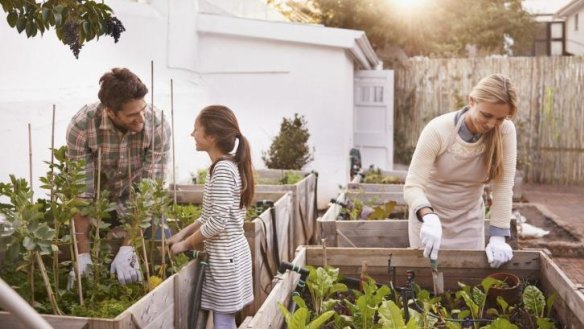Canberra Gardener: How to grow vegies in shady spots

The sun has been hot and shining over much of our landscape every day. However, there are some spaces in our gardens that are shaded and we often wonder what will grow well there. This could be on the southern side of the house or in a position shaded by big deciduous or native trees. Our fencelines create shady spots too and sometimes we have the next door dwelling casting a shadow across our space either in the morning or afternoon. The late afternoon sun does bring sunlight from a south-west direction to many gardens.
Partial shade is not a problem for all food gardens but full shade is a real challenge. There are few vegetables that will grow in full shade, so if you have such an area, stay with shade-loving shrubs and flowers.
If you have morning sun or afternoon sun, then there are quite a number of vegetables that will tolerate some shade.
Kale can be grown over many months of the year. It is a good source of calcium, iron, beta carotene and vitamins C and E. In the kitchen, you can add kale to soups and casseroles, or braise with onions and add to bacon dishes.
The Italian cavolo nero is now well known, with its long dark green leaves. However, the Red Russian and Scottish kales provide beautiful, ragged edged leaf supplies to add to your selection. You will need to provide protection from the cabbage moth, as it belongs to the brassica family. Use Dipel as a natural caterpillar sprays or cover with a pestguard net to keep the moths away.
Rocket is a fast-growing annual herb that can be grown in small, semi shaded spaces. It is rich in folates and potassium, along with vitamins A and C. You can add to salads to provide a tangy bite. It is great to add to pasta sauces and even add to homemade pesto. Plant out a few seeds each fortnight and you will have a continuous supply of one of the fastest-growing crops.
Radish is one of those few vegetables that are quick growing and can be planted out all the year round. So it becomes a good option for partial shade spots. You can grow just one row or a square each fortnight to keep you in supply. The fast growing salad types will produce a crop in four to six weeks. Again, provide the plants with lots of well rotted compost when planting out. In the hot months, definitely plant radish in a location that provides shade in the hot afternoons. Mustard greens and the related mizuna will also grow well in partial shade. These can provide you with a good selection of leafy alternatives to add to a salad mix.
Spinach is a fast-growing, nutritious vegetable that also needs a rich, fertile soil but can do well in partial shade. Keep the soil moist with regular waterings when the days are hot. Give the plants a dose of seaweed or fish emulsion foliar sprays each fortnight. You can pick baby leaves in just a few weeks after planting.
Silverbeet is a neighbouring leafy green which can be planted from early spring to autumn to provide a nutritious alternative to spinach. The rainbow chard has lovely red and yellow stems and the Italian erbette with its flavoursome, tender leaves is another good option to plant. Kohlrabi is a member of the brassica family that has been grown widely in northern Europe for many centuries. Its name can be roughly translated as cabbage turnip. It is fast growing and takes just eight to 10 weeks to produce nutritious purple or light green bulbs filled with goodness. It can be planted anytime from spring to late summer in the cooler regions. It does enjoy sunshine but can take partial shade. Make sure that you have added lots of compost to provide a humus rich soil. Keep well watered, to promote continuous growing.
Leeks are, on the other hand, one of the slowest-growing vegetables but they are easy to grow and can withstand partial shade. They are a good source of potassium, calcium and vitamin C. Dig in plenty of compost and make sure that you ensure good drainage, when you are planting out the seedlings. It is best to prepare for an early springtime planting. Rhubarb is another long growing vegetable that can manage in partial shade. In autumn you can begin preparing a deep bed for planting out the rhubarb crowns in winter. It is preferable to provide morning sun, rather than the hot afternoon sun.
So you have many options in gardening even when you do not have the privilege of full sun. If fact, many of the vegetables that I have noted, do much better when they are shaded from the hot afternoon sun.
This week in the garden
To produce a late summer harvest, plant out a row of salad radish, rocket and Asian greens.
Plant out cabbage, broccoli and brussel sprouts seedlings for a late-winter harvest.
Plant out kohlrabi, spinach and silverbeet seeds direct into well-prepared garden beds.
Trim back rosemary and lavender bushes but make sure to retain a little of current year's growth on the remaining branches.
Weeding is taking all of our time, after all the late summer rains. Aim to do this task in the early evening with the setting sun and the radio on to provide some relaxing music.
Owen Pidgeon runs the Loriendale Organic Orchard near Hall.